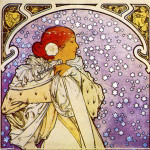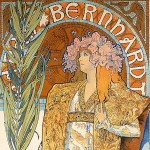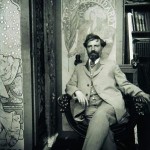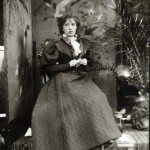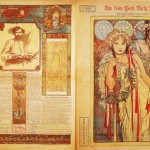The twenty years of Alphonse Mucha in the “Ville-Lumière”. The father of Art Nouveau is told through opera divas, jewelry boutiques and seances in the Paris of the Exposition Universelle
“I had no clothes. So I made do with a tail coat hired for ten francs. Since none of the trousers suited me, I decided to put on one of my own, which were acceptable if you didn’t look at them from close up. Having dressed up, and abandoned the roast duck idea, I sat in a corner of the room with a notebook for sketches and a handful of pencils”. “It was the day after Christmas of 1894, to be precise in the evening, at the peak of his career. It was then that the artistic fate of Alfred Mucha would change forever. At Theatre de la Renaissance, Gismonda, is on the bill, with the Divine of Parisian melodrama, Sarah Bernhardt, who Victor Hugo loved to call “the golden voice”. The Printer Brunhoff, urged by the actress to create a new poster for the show before the end of the year had no illustrators available. The only one available during the holidays was the young artist of Ivančice, who until then had never produced anything of the kind. Right after the performance, Mucha got to work, night and day. So, in a flash, before the end of the year, something revolutionary was ready to cover Paris. It was an image of Bernhardt dressed in a tunic carved in gold, with a garland of flowers resting on a cascade of red hair, and a laurel branch carried gently. It was a new style, something never seen before. Golds, spirals, carvings, pastel colors, all details that would soon become the trademarks of the artist and his contemporaries baptize “le style Mucha”. The image won over Bernhardt, who being in love with the poster, signed a contract for six years, so he became the personal creator: from that day on Mucha would have designed her costumes, her jewelry and other decorations of her shows.
 This way, semi penniless artist, who lived in a small studio above a restaurant where he used to go, caused the doors of the beautiful Parisian society to open wide. He moved into a luxurious apartment in the rue Vavin, receiving artists and personalities of the great world. Fascinated by spiritualism, he arranged semi-serious evenings with his guests, where they tried to communicate with the beyond. His interest in ancient and mysterious cults blended with a typically mundane practice in vogue in those years. Mucha, who already from the beginning in the capital, had always loved to be surrounded by Czech expatriates and artist friends. Among them was Paul Gauguin and the Polish artist Wladyslav Slewinski, with whom he had decorated the facade of the restaurant in his first lodging, a meeting place of artists in the neighborhood. After the first years as a student, he was involved in the creation of advertising posters, catalogs and calendars, a job that he would never abandon during his stay in France. His works were born in a studio that over the years transformed more and more into a room of wonders. Extravagant objects inspired him in his creation. In addition, it was in these rooms where he took numerous photographic portraits of his models. These images make up an important personal library and a valuable document on women of his time. Mucha would use them throughout his career as an artist. However, his true muse was Sarah Bernhardt. After Gismonda, the artist created a series of other posters for the actress: Lorenzaccio, La dame aux camelias, Hamlet et Médée. These would make the Czech a celebrity. It is said that people loved his wall posters so much that they cut them off with a razor and collected them.
This way, semi penniless artist, who lived in a small studio above a restaurant where he used to go, caused the doors of the beautiful Parisian society to open wide. He moved into a luxurious apartment in the rue Vavin, receiving artists and personalities of the great world. Fascinated by spiritualism, he arranged semi-serious evenings with his guests, where they tried to communicate with the beyond. His interest in ancient and mysterious cults blended with a typically mundane practice in vogue in those years. Mucha, who already from the beginning in the capital, had always loved to be surrounded by Czech expatriates and artist friends. Among them was Paul Gauguin and the Polish artist Wladyslav Slewinski, with whom he had decorated the facade of the restaurant in his first lodging, a meeting place of artists in the neighborhood. After the first years as a student, he was involved in the creation of advertising posters, catalogs and calendars, a job that he would never abandon during his stay in France. His works were born in a studio that over the years transformed more and more into a room of wonders. Extravagant objects inspired him in his creation. In addition, it was in these rooms where he took numerous photographic portraits of his models. These images make up an important personal library and a valuable document on women of his time. Mucha would use them throughout his career as an artist. However, his true muse was Sarah Bernhardt. After Gismonda, the artist created a series of other posters for the actress: Lorenzaccio, La dame aux camelias, Hamlet et Médée. These would make the Czech a celebrity. It is said that people loved his wall posters so much that they cut them off with a razor and collected them.
All this happened in a city in great cultural ferment, which was preparing to host the Universal Exhibition of 1889. Paris was the epicentre of all the artistic avant-garde and the technological revolutions of the century. It was at this time that his style had been affirmed, and was destined to inspire. It was the so-called Art Nouveau, consisting of vaporous forms, enveloped as in the folds of a skirt, or in cascades of hair. The woman and her feminine charms are the emblem of these compositions. The success of the artist was such that the famous jeweler Fouquet asked Mucha to design his new boutique on Rue Royale. The result was extraordinary, from the lamps, the mosaic floors, to the mirrors chiseled from the bronze of a peacock that made the wheel, the environment is a triumph of his art.
In the moment of the peak of his success, when a relationship linked him to the mysterious Berthe de Lalande, who posed as a model for many of his shots and portraits, the artist met Maruška, a young Czech woman who he married a few years later in a village near Prague. It was from this new relationship, which brought him even closer to his roots and homeland, and the growing frustration of having become a commercial artist, that a new artistic and human awareness starts to grow in Mucha. While the orders for advertising illustrations continued to flourish, his interests were now oriented towards painting, ancient cults, and Slavic history. That is how in 1906, at the suggestion of the Baroness Rothschild, he decided to head for the United States. His American dream was to make a lot of money in a short time in order to be able to finally devote time to a more intimate and historical art form and to return home. Having closed the Parisian studio, theatre of his most appreciated creations, he set off for New York with Maruška. By the time, Mucha was such an internationally renowned artist, that before his arrival, the New York Daily News dedicated a special edition to him. However, this is a story from the new world, far from the bohème and the splendour, the early work and the poorly heated ateliers of Paris at the end of the century. Far from the city which enshrined Mucha as the father, and visionary, behind what is now called Art Nouveau.
by Edoardo Malvenuti





